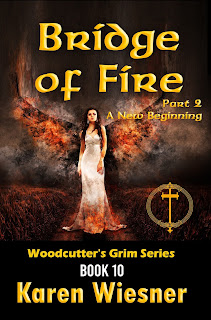Writer's Craft Article by Karen
S. Wiesner
Tension and Twists,
Part 2
Based on COHESIVE STORY BUILDING (formerly titled FROM FIRST DRAFT TO FICTION NOVEL {A Writer's Guide to Cohesive Story Building}) by Karen S. Wiesner
This is the second of three posts focusing on how (and why) to build tension and twists into your fiction.
Release and
downtime are also absolutely necessary in every
story. But only with a cohesive logic in the build-up of downtime,
suspense, and black moment, and with an equally meshed logical resolution, will
your reader be left satisfied and smiling upon closing the book. This in no
way, however, means that you can’t throw a twist in at the end of your
story—provided that it fits logically and cohesively with what you’ve already
set up in the beginning and middle of the book. Let's talk about incorporating
effective twists into your fiction.
Incorporating
Twists
Most twists come at the end of a story. But this isn’t to say you couldn’t have twists at other points in the story as well as more than one twist, each coming at various intervals. Adding twists to your stories are exciting to read because the author leads the reader so effectively to believe one thing (a thing that also makes perfectly logical and cohesive sense) while completely turning the tables at the last minute.
Putting twists into each story spark is a sure-fire way to turn a suspenseful story into a nail-biting one. To get started, ask yourself, In light of the rest of my story and the cohesiveness I need to provide, what’s the most shocking thing I could have happen? What is the reader absolutely not expecting?
A twist should be set up properly from the very beginning of the book to make it believable. It must fit logically and cohesively with what you’ve already set up in the beginning and middle of the book. Using an outline can help you prepare for that without requiring you to write an entire draft before you realize your resolutions are too predictable. Resolutions need to fit perfectly with every angle this twist presents.
Think about the book (and the movie, which is just as good) Presumed Innocent, by Scott Turow. If you haven’t read or watched this before, I encourage you to do it at your earliest opportunity. The twist at the end utterly haunted me for years afterward. The truth was there before my eyes the whole time, yet I never saw it, and it punched me in the stomach brutally when it came.
A twist is so breathtaking because it comes out of nowhere (despite the fact that the reader will have to concede that all the evidence to point to it was there from the start) and it satisfies the reader worlds more than a predictable outcome ever can. In some cases, the twist may be the very thing the reader wanted to happen but didn’t dare let himself hope for.
When I finished the outline for my action/adventure romance Undercover Angel, the seventh book in Incognito Series, I found myself with a story that made complete sense, following the course that I’d set up from the beginning and throughout the middle to the end. Nevertheless, I was ultimately disappointed with the outcome and knew my readers would be, too. The resolutions were simply too predictable to truly satisfy me. So I sat down and thought to myself, What is the most shocking thing I could possibly make happen in order to make the reader gasp when she gets to the end of the story? When I realized what it was, I went back into my outline and reshaped it from start to finish to fit this new twist as well (better, really) as the predictable resolutions did. When my critique partner read the outline, she said she’d fully expected the predictable resolution and never had the slightest clue about the twist until it hit her square in the stomach—and she loved it. This trick worked to fulfill the breathtaking longing in the reader for an unexpected shock.
Always look for the unexpected twist in your story because it makes it so memorable. There are always obvious scenarios that can be developed in response to the sparks introduced in your story but your goal is to generate the unexpected in your readers. Discombobulate them within the confines of logic, satisfactory resolutions, and cohesion.
In Part 3, we'll talk about tips for creating tension and suspense.
Find out more here about COHESIVE STORY BUILDING here:
http://www.writers-exchange.com/cohesive-story-building/
https://www.amazon.com/dp/B00QJ09DQM
What's your favorite twist in a book or movie? Leave a comment to tell me about it!
Happy writing!
Karen Wiesner is an
award-winning, multi-genre author of over 140 titles and 16 series. Visit her
here:
https://karenwiesner.weebly.com/
http://www.facebook.com/KarenWiesnerAuthor
https://www.goodreads.com/karenwiesner
http://www.writers-exchange.com/Karen-Wiesner/







































